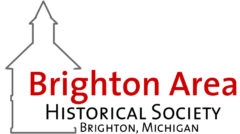 To commemorate the recent progress in the restoration of the old building, it was felt that a summary of the work of the Society’s Old Town Hall Restoration Committee and a short review of the building’s history was appropriate.
To commemorate the recent progress in the restoration of the old building, it was felt that a summary of the work of the Society’s Old Town Hall Restoration Committee and a short review of the building’s history was appropriate.
The Society has been conducting fund raising projects to restore the Hall for future use as a place to display the many artifacts donated, relating to the history of the Brighton Area, and a meeting pace for that organization. To expedite there efforts the Old Town Hall Restoration Committee came into being.
In 1984 the building was listed on the Michigan Historic Site Register and a marker installed. October 1987 saw the stripping of red paint from brick and trim, which had been applied to conceal alterations which were made to accommodate those using the building: removal and changing of windows, doors, etc. Caulking and repainting of trim was accomplished in 1988, also the building of a replica of the tower. September 23, 1989 the tower was dedicated following its raising to its original position atop the Hall.
The Restoration Committee is a dedicated group, not resting on their laurels. Plans for future fundraisers are underway. The support of the entire area is vital to complete the task.
Several small communities, with a post office, blacksmith shop, mill and small stores were scattered throughout Brighton Township at the time of its organization in 1837. However, many of those in the southwestern corner of the township felt they’d get a better allocation of tax monies and under that aegis a charter for Brighton Village was prepared March 7, 1867.
Within three weeks of the village council was formed; president, clerk, treasurer and trustees. For 30 years the council met in rented rooms; some at 50 cents per month, some at the cost of lighting (candles and oil lamps.) The treasurer was bonded, record books and eventually some chairs with “wood bottoms” were purchased. These village officers did their best to conduct the business of the community in a manner which would be in the best interests of the residents and merchants.
Early ordinances regarding the treatment of riotous persons were written as were those prescribing no liquor on Sundays, no shooting, no ball playing on village street, animals were not to be hitched to trees, livestock was not allowed to roam the street.
Other concerns the council encountered included selection of fire fighting equipment and storage space for this equipment. A village lockup was needed and a permanent place to meet.
Following the coming of the railroad in 1871, the west side of town (west of Ore Creek) boomed with merchants and residents. Friction as to location of the Post Office, construction of sidewalks, amount of gravel on the streets, etc., developed between the “Eastsiders” and the “Westsiders.”
In 1877 the residents petitioned for a building suitable for a village hall, a lockup and fire fighting equipment. A location suitable to both sides was needed. In March, 1874, Godfrey Westphal had been granted permission to build a store, which burned October 28, 1875, on the site of the present Old Town Hall. The city bought the Westphal property for $350, but no building started because they felt the estimates of $1673 an $1850 were too high.
The following year a second petion arrived. Wm. Pipp bid $2460. James Collett’s bid of $1950 with completion the next year was successful. Collett then found a $200 error in his bid. Council cooperated and granted him the extra funds. February, 1880, was probably the first time the building was used.
To relieve the conflict of the “East” and “Westsiders”, a fire bell was installed in the Hyne elevator when one was placed in belfry of the Town Hall. Cisterns to supply water for fire fighting were located on both sides of town.
The first floor accommodated the hand pumper and other fire fighting equipment that the volunteer “Brighton Hook and Ladder Company #1” (February 1876) had acquired. Two large doors opened outward on the front of the building with a smaller entry next to it. The lockup was in the back. The second floor was used by the council as meeting rooms and for elections. Justice was dispensed in this room by the Justices of the Peace or six man juries. For many years the entire front of the second floor held political orators seeking local, county and state positions and was used for special events such as Memorial Day services (begun by the Grand Army of the Republic after the Civil War, 1884.)
In 1927, a small space was set aside for a library upstairs. When the fire department built more spacious quarters across Main Street after WW II, the library moved downstairs until 1957, when the Kiwanians renovated the old Detroit Edison substation for the library’s use. Some time prior to the Fire department’s move out of the building, the tower and bell had been removed as a perceived safety measure. ( The bell has been installed in a prominent position in front of the department’s latest building, 615 W. Grand River.)
By 1966 the recently vacated Brighton State Bank building, just west of the mill pond, was purchased and the city moved its offices to that location. The library moved back into the Old Town Hall until 1981, when it was incorporated into the new municipal building. The city then began renting the first floor to a book seller.
Compiled and edited by Marieanna Bair from Wm. Pless “Michigan Memorabili”
